The Two Wheeler Anti-lock Braking System Market is estimated to be valued at USD 18.0 billion in 2025 and is projected to reach USD 61.6 billion by 2035, registering a compound annual growth rate (CAGR) of 13.1% over the forecast period.
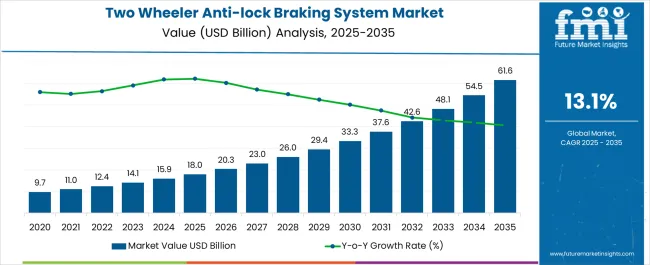
| Metric | Value |
|---|---|
| Two Wheeler Anti-lock Braking System Market Estimated Value in (2025 E) | USD 18.0 billion |
| Two Wheeler Anti-lock Braking System Market Forecast Value in (2035 F) | USD 61.6 billion |
| Forecast CAGR (2025 to 2035) | 13.1% |
The Two Wheeler Anti-lock Braking System (ABS) market is experiencing robust growth, driven by the increasing adoption of safety features in motorcycles and scooters across both developed and emerging markets. Rising road traffic, coupled with growing consumer awareness about vehicle safety and accident prevention, is enhancing demand for advanced braking solutions. Regulatory mandates in various countries requiring ABS installation in two wheelers are further supporting market expansion.
Technological advancements in braking systems, including lighter and more responsive electronic controls, are improving vehicle handling and reducing stopping distances. Increasing integration of ABS with other safety and rider assistance features is enhancing overall vehicular safety. Manufacturers are focusing on product innovation, cost optimization, and enhanced reliability to attract both OEMs and aftermarket consumers.
Growing investments in road infrastructure and the rising popularity of high-speed and premium motorcycles are contributing to adoption As government regulations, safety consciousness, and technological innovations continue to influence market dynamics, the Two Wheeler ABS market is positioned for sustained growth over the coming decade.
The two wheeler anti-lock braking system market is segmented by number of operating channels, sales channel, and geographic regions. By number of operating channels, two wheeler anti-lock braking system market is divided into One Channel - One Sensor, Three Channel - Three Sensor, and Four Channel - Four Sensor. In terms of sales channel, two wheeler anti-lock braking system market is classified into Original Equipment Manufacturers and After-Market Sales. Regionally, the two wheeler anti-lock braking system industry is classified into North America, Latin America, Western Europe, Eastern Europe, Balkan & Baltic Countries, Russia & Belarus, Central Asia, East Asia, South Asia & Pacific, and the Middle East & Africa.
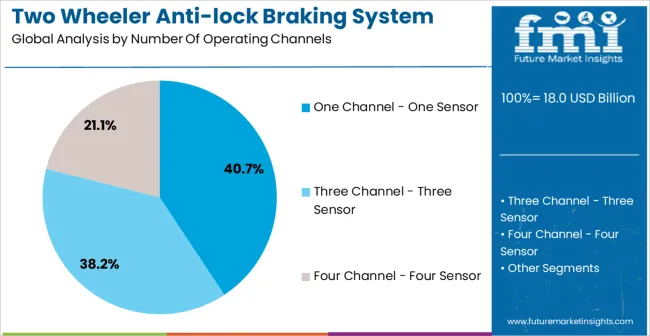
The one channel - one sensor segment is projected to hold 40.7% of the market revenue in 2025, establishing it as the leading operating channel configuration. Its adoption is being driven by the balance it provides between cost-effectiveness and safety enhancement for entry-level and mid-range motorcycles and scooters. This configuration allows independent control of one wheel, typically the front, ensuring stability and reducing wheel lock-up during sudden braking.
Ease of integration, lower complexity, and reduced maintenance requirements have strengthened preference among OEMs and two wheeler manufacturers. The segment benefits from increasing regulatory compliance and consumer demand for safer, affordable two wheelers without significantly increasing production costs.
Continuous improvements in sensor technology, reliability, and response times further enhance its adoption As two-wheeler sales grow globally, particularly in regions with expanding urban mobility and traffic congestion, the one channel - one sensor segment is expected to maintain its leadership, supported by cost efficiency, regulatory alignment, and operational reliability.
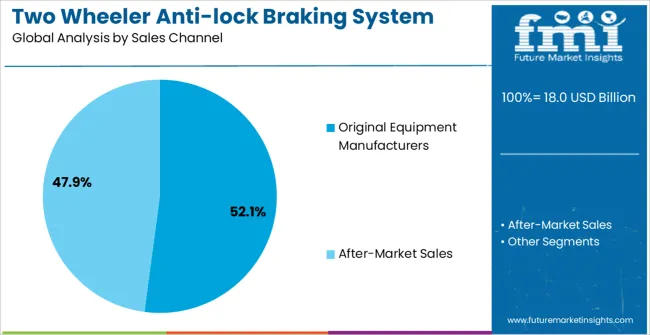
The original equipment manufacturers (OEM) sales channel segment is expected to account for 52.1% of the market revenue in 2025, making it the leading distribution channel. Its growth is being driven by the rising integration of ABS as a standard safety feature in new two wheelers, particularly in compliance with national regulations. OEMs offer end-to-end vehicle solutions with factory-fitted ABS, ensuring optimal performance, reliability, and warranty coverage, which is highly valued by consumers.
Partnerships with ABS component suppliers, advancements in manufacturing processes, and economies of scale are facilitating widespread adoption. Increasing consumer awareness about vehicle safety and preferences for pre-installed braking systems further reinforce the dominance of OEM channels.
The segment also benefits from the introduction of premium and high-speed motorcycle models, where factory-installed ABS is considered essential As demand for safer two wheelers continues to rise and regulations become more stringent, OEMs are expected to remain the primary channel for ABS distribution, supported by technological innovation, regulatory compliance, and consumer trust.
Comprising a hydraulic control unit, master cylinder assembly, power booster, and electronic control units, anti-lock braking systems are gaining popularity as an automobile safety system owing to the improvements it makes to the braking performance.
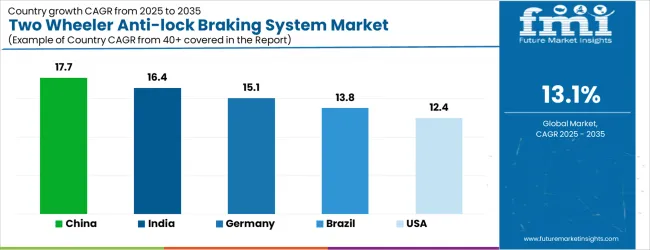
| Country | CAGR |
|---|---|
| China | 17.7% |
| India | 16.4% |
| Germany | 15.1% |
| Brazil | 13.8% |
| USA | 12.4% |
| UK | 11.1% |
| Japan | 9.8% |
The Two Wheeler Anti-lock Braking System Market is expected to register a CAGR of 13.1% during the forecast period, exhibiting varied country level momentum. China leads with the highest CAGR of 17.7%, followed by India at 16.4%. Developed markets such as Germany, France, and the UK continue to expand steadily, while the USA is likely to grow at consistent rates. Japan posts the lowest CAGR at 9.8%, yet still underscores a broadly positive trajectory for the global Two Wheeler Anti-lock Braking System Market. In 2024, Germany held a dominant revenue in the Western Europe market and is expected to grow with a CAGR of 15.1%. The USA Two Wheeler Anti-lock Braking System Market is estimated to be valued at USD 6.7 billion in 2025 and is anticipated to reach a valuation of USD 6.7 billion by 2035. Sales are projected to rise at a CAGR of 0.0% over the forecast period between 2025 and 2035. While Japan and South Korea markets are estimated to be valued at USD 880.8 million and USD 562.0 million respectively in 2025.
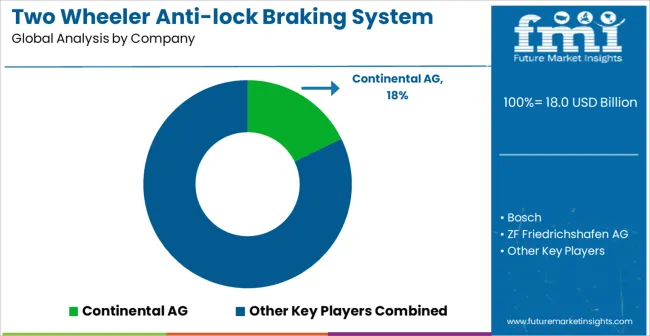
| Item | Value |
|---|---|
| Quantitative Units | USD 18.0 Billion |
| Number Of Operating Channels | One Channel - One Sensor, Three Channel - Three Sensor, and Four Channel - Four Sensor |
| Sales Channel | Original Equipment Manufacturers and After-Market Sales |
| Regions Covered | North America, Europe, Asia-Pacific, Latin America, Middle East & Africa |
| Country Covered | United States, Canada, Germany, France, United Kingdom, China, Japan, India, Brazil, South Africa |
| Key Companies Profiled | Continental AG, Bosch, ZF Friedrichshafen AG, Brembo, Hitachi Astemo, Ltd., Bajaj Auto, TVS Motor Company, Honda, Aisin Seiki, and Mando Corporation |
The global two wheeler anti-lock braking system market is estimated to be valued at USD 18.0 billion in 2025.
The market size for the two wheeler anti-lock braking system market is projected to reach USD 61.6 billion by 2035.
The two wheeler anti-lock braking system market is expected to grow at a 13.1% CAGR between 2025 and 2035.
The key product types in two wheeler anti-lock braking system market are one channel - one sensor, three channel - three sensor and four channel - four sensor.
In terms of sales channel, original equipment manufacturers segment to command 52.1% share in the two wheeler anti-lock braking system market in 2025.






Our Research Products

The "Full Research Suite" delivers actionable market intel, deep dives on markets or technologies, so clients act faster, cut risk, and unlock growth.

The Leaderboard benchmarks and ranks top vendors, classifying them as Established Leaders, Leading Challengers, or Disruptors & Challengers.

Locates where complements amplify value and substitutes erode it, forecasting net impact by horizon

We deliver granular, decision-grade intel: market sizing, 5-year forecasts, pricing, adoption, usage, revenue, and operational KPIs—plus competitor tracking, regulation, and value chains—across 60 countries broadly.

Spot the shifts before they hit your P&L. We track inflection points, adoption curves, pricing moves, and ecosystem plays to show where demand is heading, why it is changing, and what to do next across high-growth markets and disruptive tech

Real-time reads of user behavior. We track shifting priorities, perceptions of today’s and next-gen services, and provider experience, then pace how fast tech moves from trial to adoption, blending buyer, consumer, and channel inputs with social signals (#WhySwitch, #UX).

Partner with our analyst team to build a custom report designed around your business priorities. From analysing market trends to assessing competitors or crafting bespoke datasets, we tailor insights to your needs.
Supplier Intelligence
Discovery & Profiling
Capacity & Footprint
Performance & Risk
Compliance & Governance
Commercial Readiness
Who Supplies Whom
Scorecards & Shortlists
Playbooks & Docs
Category Intelligence
Definition & Scope
Demand & Use Cases
Cost Drivers
Market Structure
Supply Chain Map
Trade & Policy
Operating Norms
Deliverables
Buyer Intelligence
Account Basics
Spend & Scope
Procurement Model
Vendor Requirements
Terms & Policies
Entry Strategy
Pain Points & Triggers
Outputs
Pricing Analysis
Benchmarks
Trends
Should-Cost
Indexation
Landed Cost
Commercial Terms
Deliverables
Brand Analysis
Positioning & Value Prop
Share & Presence
Customer Evidence
Go-to-Market
Digital & Reputation
Compliance & Trust
KPIs & Gaps
Outputs
Full Research Suite comprises of:
Market outlook & trends analysis
Interviews & case studies
Strategic recommendations
Vendor profiles & capabilities analysis
5-year forecasts
8 regions and 60+ country-level data splits
Market segment data splits
12 months of continuous data updates
DELIVERED AS:
PDF EXCEL ONLINE
Two Wheeler Suspension System Market Size and Share Forecast Outlook 2025 to 2035
Two Wheeler Fuel Injection System Market Size and Share Forecast Outlook 2025 to 2035
Two-Wheeler Lubricants Market Size and Share Forecast Outlook 2025 to 2035
Two Wheeler Rental Market Size and Share Forecast Outlook 2025 to 2035
Two-Wheeler Aftermarket Components & Consumables Market Size and Share Forecast Outlook 2025 to 2035
Two Wheeler Safety Solutions Market Size and Share Forecast Outlook 2025 to 2035
Two Wheeler Handlebars Market Size and Share Forecast Outlook 2025 to 2035
Two Wheeler Crash Guard Market Size and Share Forecast Outlook 2025 to 2035
Two-Wheeler Lead Acid Batteries Market Analysis - Size, Share, and Forecast Outlook 2025 to 2035
Two Wheeler Accessories Aftermarket Growth - Trends & Forecast 2025 to 2035
Two Wheeler Crankshaft Market Growth – Trends & Forecast 2024-2034
Two Wheeler Backrest Market
Two Wheeler Electric Starter Magnet Market
Two Wheeler Chain Sprocket Kit Market
Two Wheeler Footrest Market
Two-wheeler ECU Market
Two Wheeler Fenders Market
Two Wheeler Seats Market
Two-wheeler Battery Market
Network File System Market Size and Share Forecast Outlook 2025 to 2035

Thank you!
You will receive an email from our Business Development Manager. Please be sure to check your SPAM/JUNK folder too.
Chat With
MaRIA